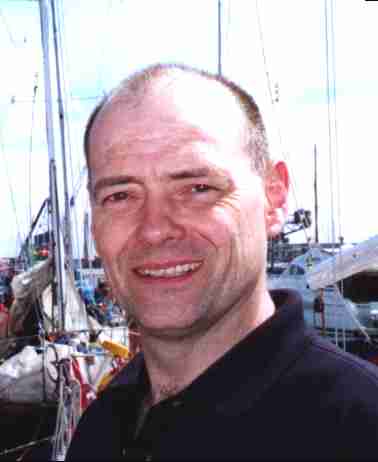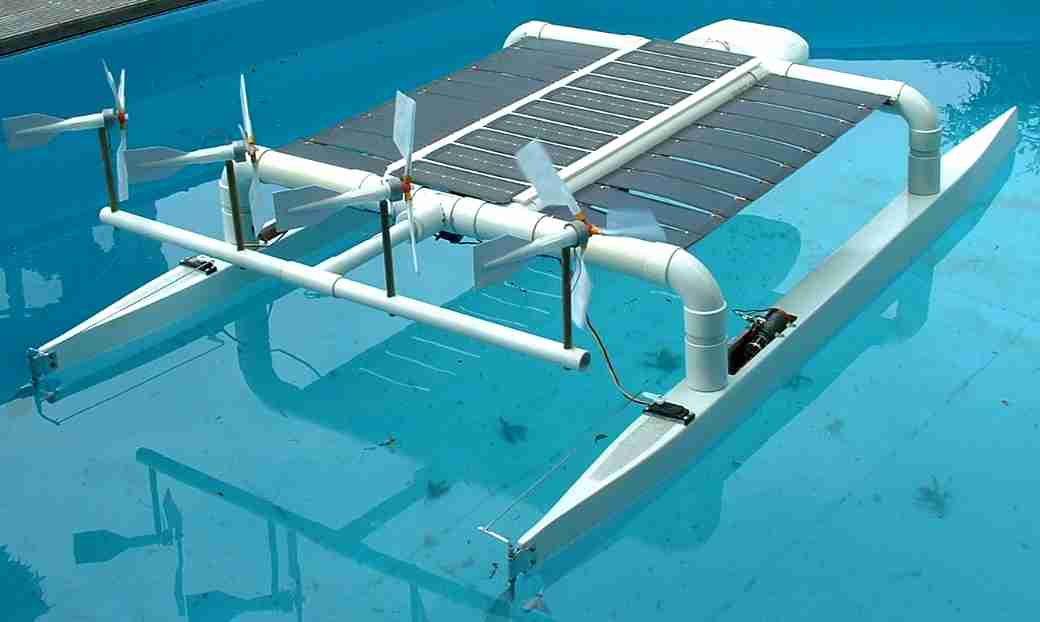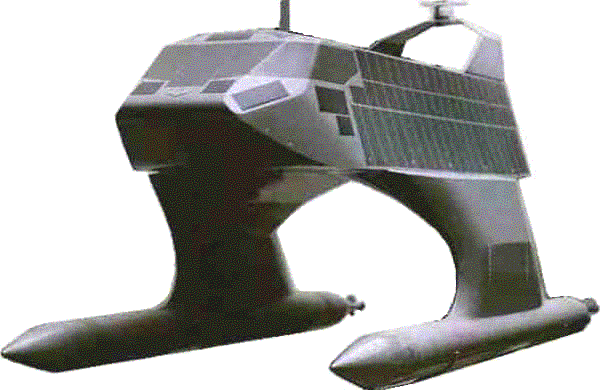|
|
|
|
HOME | BIOLOGY | FILMS | GEOGRAPHY | HISTORY | INDEX | INVESTORS | MUSIC | NEWS | SOLAR BOATS | SPORT |
|
|
Designing a boat is always a compromise. How big should the boat be? What type of hull configuration? The answer is to decide what the boat is to do, then look at the type of hull best suited to the purpose. First of all define your objectives:
1. Solar Navigator has to be capable of cruising in all sea conditions. 2. The hulls must be efficient above all to make the most of a limited electricity supply. 3. The hulls need to carry a large area of solar panels with least wind resistance. 4. The solar panel array should capture as much sun as possible in practical terms. 5. Lastly, the crew should be well catered for - safety and survival are paramount.
These are the main considerations, even for an autonomous vehicle.
Nelson - on Hull Design
You may agree that as nobody had proposed or attempted such a feat way back in 1994 when Nelson first proposed a Solar Powered World Navigation, there was not much to go on. Generally, in engineering design terms, it is always a good idea to see what has been done before. For this project, there are plenty of hull designs to consider, some of which are suitable for solar boats. These include catamarans, trimarans and the more exotic SWATH vessels. I decided to start with SWATH, purely on the basis that they potentially offer a smooth ride.
Unfortunately, when I started there was not much information to go on and I have no formal training as a marine architect. So, I did what I always do. I decided to compile my own data from practical experiments. To date I have built 10 multi-hull models in a series. I'm currently building number 11 as a consultant to as proposed project - a design which has never been tried before and which Max Energy Limited is trying to interest officials in, due to the efficiency advantages and so cost savings that may be made where budgets are strained. NATO may well be able to save considerable sums by employing automation.
MY FIRST BOAT
When I was a schoolboy teenager (1970s), I built one of the first small boats of the jet ski type, only with an exposed (semi-shrouded) propeller. All my friends said the design wouldn't catch on - so much for that! I don't pay too much attention to what my friends think anymore. In fact it makes be laugh when they pooh, pooh my ideas. When they do that I know I'm onto something.
The picture below shows the hull under construction. The build began in my bedroom in Old Orchard Road in Eastbourne, when I was at Ratton Secondary School. That is amusing, because my bedroom was on the top floor. You can imagine the mess. I used an old lawnmower engine (Briggs & Stratton). The boat was completed in a garage in Beacon Road in Seaford, which my father allowed me to take over (thanks dad), and later at Newhaven where I had a workshop in Butchers Lane. Unfortunately this interesting boat was disposed of during a house move - a storage problem. Pity!
Nelson's first full size boat - Low two seat Jet Ski style surface skimmer. Garage workshop 24 Beacon Road, Seaford.
As you can see from the above, as a schoolboy (possibly when most people experiment), I was not afraid to try different things. Fortunately, I've not yet lost that ability. I knew this project would be time consuming, experiment wise, and I also reckoned I'd go up a few dead alleys. As it turned out, all of the models I tested worked to some degree and each one highlighted a particular shortcoming, which is of course all part of the development process. I now have quite a bit of practical experience to draw on from each of the boats I've built. One difficulty, a human failing, it that it is difficult to scrap something immediately when it is wrong, because of all the time spent on it. You might be able to imagine the depression that can cause. Did I say depression, well, at least a pretty foul mood for a while.
I now take the Edison light bulb view (he made a 1,000 prototypes). Each design is not a failure, it is a milestone in the passage to a better way.
SWATH
The first two models were 1/10 scale semi-submerged SWATH hulls. Talk about going in at the deep end. SWATH vessels are one of the most difficult boats to design. This is partly because the weight has to be so precise when balanced against the load, and partly because balance and reserve buoyancy are also difficult to assess, without practical reference to reflect against.
Despite these difficulties, the second SWATH, pictured elsewhere on this site, performed rather well. One problem is leaky prop-tube seals at this scale. I used 'O' ring seals, which were the best, but still seeped. Eventually, I installed miniature water (bilge) pumps and sensors to automatically bail the hulls.
Having worked out a practical design, I then discovered it might not be practical cost wise. Hence, another reason to try other designs.
See Juliet Marine's subsequent patent and very interesting GHOST stealth fighter boat. I thought I was stretching the boundaries of practicality when thinking of moveable wings and air curtains to reduce skin friction. Not a bit of it. Gregory Sancoff bit the bullet and appears to have demonstrated that the principle is sound. Nice one Greg.
CATAMARAN
Next came a large catamaran configuration - a 100' footer. A catamaran is stable. Long thin hulls use less energy through the water and a large superstructure or deck area can be fitted for the solar panels. Last but not least going back to conventional surface hulls reduced design complications and brought down the cost of construction.
Several small simple models were tried, then two 1/20th models. I'd worked out a formula for solar cells that closely approximates real run conditions, in that solar energy is not available all the time. If I'd used the highest efficiency cells, the speed of the models would have been much faster, but of course that speed would not reflect average running. I know what you are thinking now - why bother to make the models solar powered at all, if you're just testing the hull form? Well, in fact I learned a lot about wiring and other practical aspects of solar power in doing so. Not least of all, the importance of matching motor and propeller to the available power source.
TRIMARAN
After watching as many films on boats and performance hulls as I could stand, I had to try a Trimaran. Logic dictated testing and comparing results against the SWATH and catamaran hulls. In fact the performance was not bad. I can't say how, because other competing teams will be reading this, hence there is an element of competition where technology is the key to success.
THE NEW HYBRID DESIGN
All I can say about the 11th test hull (6th development model) is that in theory it offers many advantages - the most promising of which is stability at a price the concept can afford. The downside is that it look like something out of a science fiction novel. Sorry, but unless you are a sponsor or technical associate, you'll just have to wait to see and read about the results from this one.
COMMON SENSE & SOME BASICS
Have you ever wondered how it is that a man can pull a 50 foot (ft) or 15 meter (M) long barge through a tunnel, or, that one horse can pull that same barge along a canal all day long at a steady 4-5 miles per hour (mph)?
A horse can pull 550 pounds (lbs) 1ft in one second, steadily. This amount of effort is a benchmark figure known as a horsepower. To put things in perspective, a standard Mini motor car engine develops 20-30 horsepower (HP) 15-22 kilowatt (1 Kw = 1,000 watts. 1hp = 746 watts). Whereas, most modern cars are 100hp or more.
You might think that a 1hp outboard motor would be sufficient to power the barge at 4-5mph. But this is not so. In fact it would be hard to find an outboard only developing 1hp and a 5hp outboard might only just manage the same 4-5mph as that single horse. The answer lies in the efficiency with which one form of energy is converted to another.
Solar Navigator (test rig) 2nd 1/20th catamaran model heading into wind - a spider boat
HOW DO WE ESTIMATE PERFORMANCE ?
If one horsepower = 550lbs 1ft in 1 second (s), then ignoring drag, a barge weighing 10 tons (22,400 lbs) could be accelerated to 1ft per second in about 41 seconds with 1 horsepower (hp). This is because force/mass (mass divided by force) = the rate of acceleration. You are lucky here, I’m no mathematician, accordingly all my theory is simple stuff. So hang in there because we need to understand a little theory in order to be able to estimate the performance of Solar Navigator. If you do get lost, you can refer to rule of thumb tables in this series of topics, or in many other linked pages about boat design.
To continue: If we travel @ a speed of 1ft per second, then we are doing about .66mph. Using only 1 horsepower it has taken 41 seconds to reach this speed. It is not hard to work out that it would take about 240 seconds or 4 minutes (240 divided by 41), for that one horse to pull the barge up to a speed of 4 mph. Unfortunately, that is in a perfect world and we have forgotten that considerable energy is spent in forcing the hull of the barge through the water. The energy lost or used to overcome the friction of water is called drag. Water drag must be added to the effective weight the horse must pull against. Water drag becomes more of an obstacle as speed rises.
Pounds (lbs) to Kilograms (UK & USA)
Many engineers were brought up thinking in Pounds and Horsepower. The metric system has simplified many calculations. Instead of working in ft per second, in the metric system the unit of measurement is the meter (m) and the unit of force is the Newton (N) (named after Sir Isaac Newton). The unit of mass is the kilogram (Kg). This is convenient because 1N (Newton) is the force which accelerates 1 Kg (kilogram) 1m (meter) in one second. This is written 1m/s2. The '2' after the m/s signifies that for every second the force is applied, another m/s will be added, hence per second, per second (for every second) and so on. Accordingly, if 1N is applied to a vehicle weighing 1kg for 10 seconds, the vehicle will be traveling at (have a velocity of) 10 m/s. 10 m/s is about 20 miles per hour.
For reasons of simplicity it will be worth working in metric units, unless we are trying to calculate the performance for vessels and motors rated in imperial measures. If the motors or vessel is measured in the old imperial units, we recommend that you take a little time and convert the measurements.
Just like any other object, fluids and gases have a mass and that mass needs energy to move. Mass is like weight. But mass is the weight of a substance for a given volume, normally expressed as weight for the volume of 1 liter. This was first discovered by the famous Greek philosopher Archimedes as he soaked in his bath. When he realised what he'd discovered, he jumped out of his bath naked and ran around the street shouting "Eureka."
If a standard measure of volume is used we can compare the mass of say, an equal volume lead (1 liter), against the mass of 1 liter of water, which is exactly 1 kilogram. A coincidence? Not really, Man is pretty sneaky and picked an abundant chemical compound like water so that everybody else would understand each other easily. Lead weighs roughly 11.7Kg for a volume of 1 liter. So, lead is 11.7 times more dense than water.
If we know the volume and the mass of a substance, we can say how much energy it will take to move it from one place to another. The reverse is also true. If we are moving an object of a given shape through a fluid of a known mass, we can say how much energy will be used just to go through the fluid. A lot of this depends on shape and we will look at this in more detail on another page called HULL DRAG.
Also, we have just given an extreme example. A barge is a slow moving displacement vessel. A displacement vessel is a boat or ship, which travels in the water, always moving aside its own weight in water. That is to say it does not develop lift or otherwise force itself to plane on the water surface. Slow moving boats tend to use less energy than fast ones. Why? Simply because drag multiplies as speed increases.
(If you are at school: Ask your teacher about anything you are not clear on. Make the most of your time at school to find out about subjects that interest you. If you would like to follow our project more closely, why not join our club. We welcome your comment on technical subjects)
Solar Navigator (test rig) 2nd 1/10th SWATH model this boat went faster backwards - which I now know is to do with super-cavitation and micro-bubble lubrication
WHAT WILL SOLARNAVIGATOR FINALLY LOOK LIKE ?
KEEP WATCHING TO FIND OUT
In 1995 it was proposed by our designer that a solar powered boat would be able to circumnavigate the globe using only energy from nature. He displayed the first of his development models at the Earls Court boat show in London into 1996.
With a boat the most important component on the agenda is the hull. Solar powered boats provide marine architects with new challenges. There are as yet no conventions. Nobody knows what will work best, because so little has been put to the test. We can attest to that because we've tried 5 hull designs to date, improving on each one. Two SWATH designs (one above), two catamarans and a trimaran. The 6th design is not strictly speaking a trimaran, it does though have three hulls; so we're billing it as a trimaran. A hull design like this has not been built to date, to overcome the ever present drag and wave drag dilemma.
The other major challenge is panel design. How do you increase panel area and get as much of it facing the sun when the sun moves relative to the route, and of course keep the boat stable in all seas. We wanted at least 2 kilowatts per ton of vessel mass and can comfortably achieve that. Not to detract from the incredible achievements of the PlanetSolar team, but the SolarNavigator project aims to improve on the record 0f 585 days set in May 2012 with our brand new design. Our advantage is that we have more than twice the power to weight ratio of the current record holder with a lower drag hull. This needs to be verified before we can go to the construction stage.
This project represents a unique opportunity for any global company with eco friendly ambitions. If this is of interest to you please let Blueplanet Productions know using the contact details below. See the breathtaking video of PlanetSolar below to get a handle on the sort of publicity that Solarnavigator can generate.
Planet Solar Utube & Planet Solar docking in Hong Kong
On the 4th of May 2012 the theory was proven to be correct by Raphael Domjan and his superb boat the Turanor Planetsolar, thanks to generous sponsorship by Candido Swiss watches and Immosolar, leaders in the field of solar energy management.
Now the benchmark has been set, it will undoubtedly inspire others. As with so many things once a pioneer has shown the way, inevitably, the record stands like mountain to be scaled.
EDUCATIONAL LINKS
testking 350-030 642-998 156-215.75 braindumps ST0-173 MB6-870 640-721 70-411 cissp 220-702 http://www.certkiller.com/exam-640-816.htm http://www.examsheets.com/exam/70-664.htm
The latest Solarnavigator is a battery electric trimaran with an extremely efficient active hull that runs on solar power. The model shown here is just 150mm long. The radio controlled test model is 2.1 meters in length. To make things more interesting autonomous running is now on the agenda.
|
|
|
This website is copyright © 1991- 2013 Electrick Publications. All rights reserved. The bird logo and names Solar Navigator and Blueplanet Ecostar are trademarks ™. The Blueplanet vehicle configuration is registered ®. All other trademarks hereby acknowledged and please note that this project should not be confused with the Australian: 'World Solar Challenge'™which is a superb road vehicle endurance race from Darwin to Adelaide. Max Energy Limited is an educational charity working for world peace. |
|
|
AUTOMOTIVE | BLUEPLANET | ELECTRIC CARS | ELECTRIC CYCLES | SOLAR CARS | SOLARNAVIGATOR |



